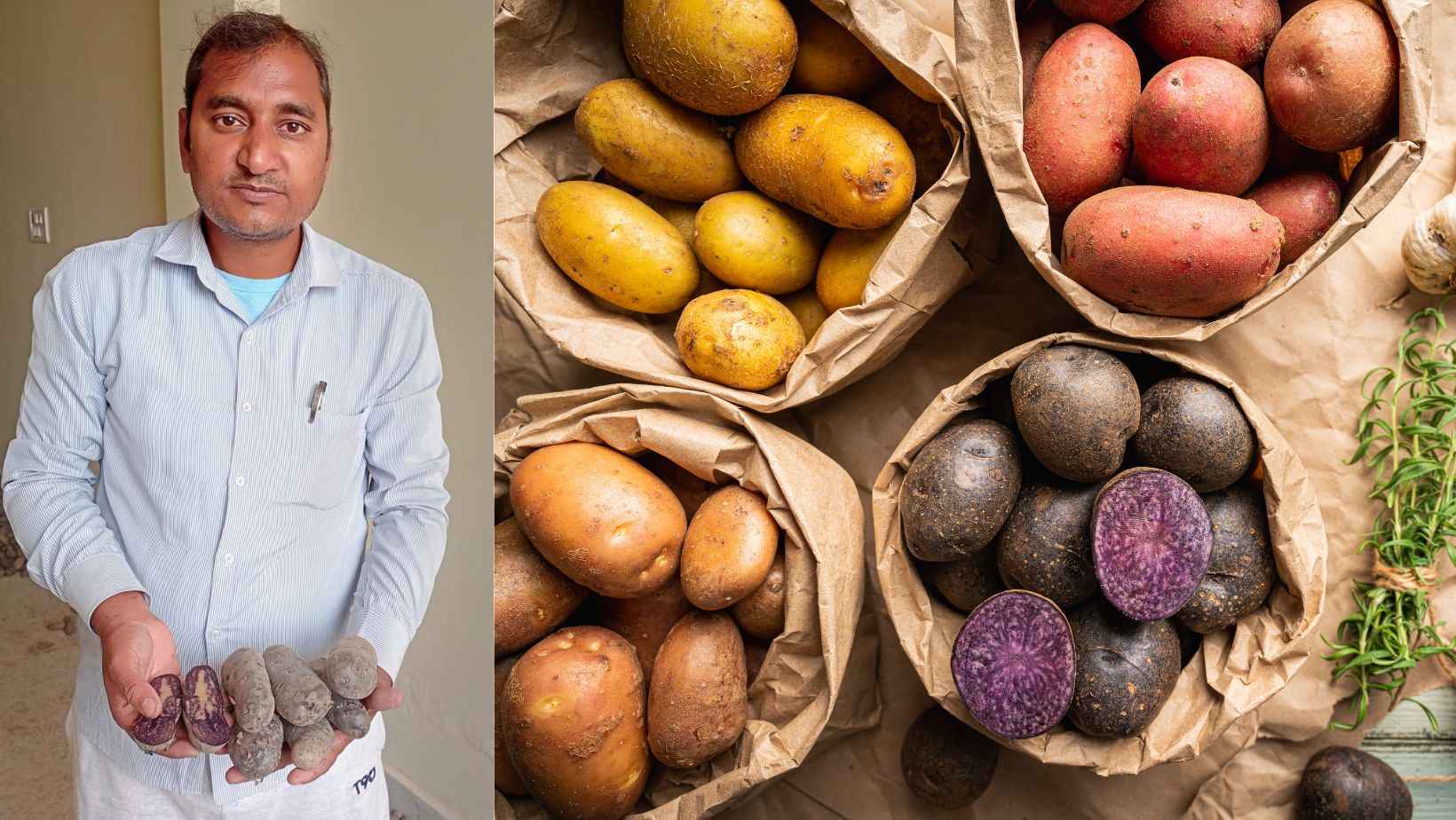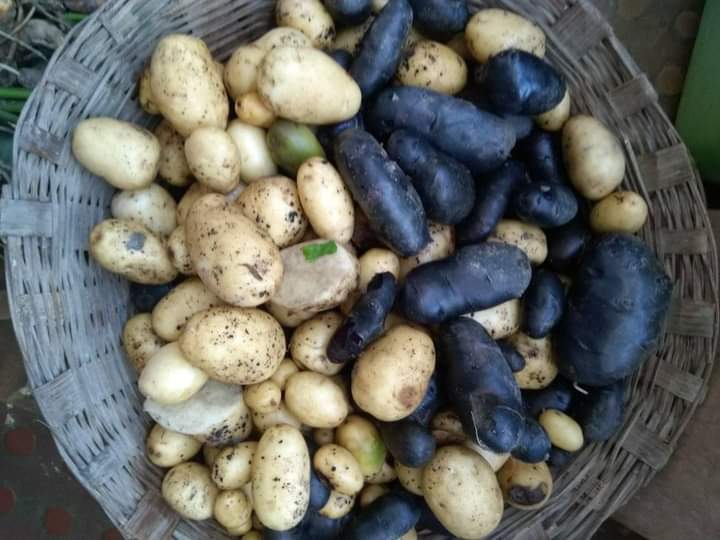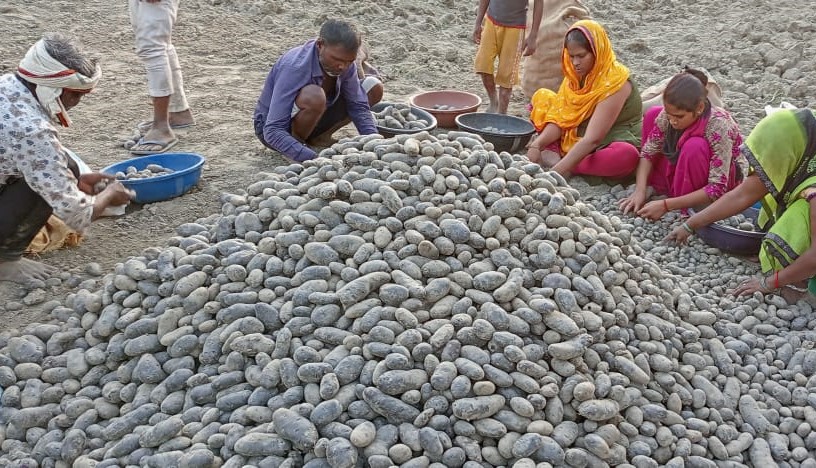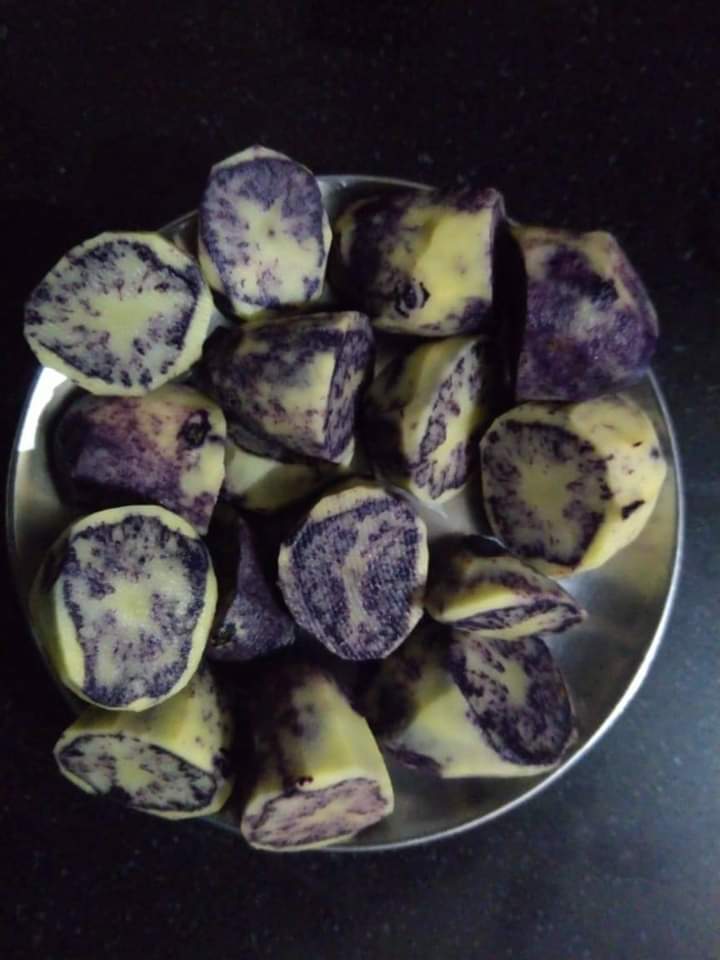Black Potatoes? Meet the Man Taking Black Super Crops to 15 States
Ravi Prakash Maurya, a farmer in Uttar Pradesh is cultivating ‘black crops’ — rice, wheat, tomato, niger seeds, turmeric and potato — all with one thing in common, their colour and presence of antioxidants. Here's why he's promoting black potatoes across India.

Ravi Prakash Maurya, 40, has become a ‘black potato champion’ of sorts. A journalist by profession, Maurya has been growing the vegetable for five years now and promoting it among other farmers spread across 15 states in India.
Following the death of his father, Maurya returned to Mansoorpur, his village in Prayagraj and took to farming in 2016. He has been growing what he calls the ‘black crops’ — rice, wheat, tomato, niger seeds, turmeric and ginger and potato — all with one thing in common, their black colour.
Having sourced the spuds from a farmer in Rae Bareilly, Uttar Pradesh, Maurya says he started growing black potatoes due to their high concentration of antioxidants beneficial for good health.
Locally known as ‘Kaala Aaloo’ (black potato) by the growers, it is far from that and is dark purple which is revealed once the spud is sliced into two. To understand more about this vegetable, let’s dive further into its background.

Where does the black potato come from?
Grown by some 50-odd farmers in the potato-growing belt of Prayagraj, Uttar Pradesh, black potatoes have yet to make their presence known in the APMCs (Agricultural Produce Market Committees). Most of these vegetables are grown to be sold just as seed material.
“A kilo of tubers yields around 15 kg of potato,” explains Maurya. Grown with farm yard manure, he spends around Rs 6,000 on inputs and harvests nearly 90 quintals per bigha, which is slightly less than regular potatoes.
Like other members of the potato family (Solanum tuberosum), they come from a tuber plant native to the Andes Mountains region in South America and are characterised by their distinctive blue-purple-black outer skin. The inner flesh of this vegetable is a brilliant purple, which remains intact even after cooking.
Grown the world over, it can be identified with different names like the Shetland Black, Purple Peruvian, Purple Majesty, All Blue, Congo, Adirondack Blue, Purple Fiesta, and Vitelotte.

How does the black potato taste?
“They have a denser texture and are slightly nuttier than the usual white potatoes,” explains Maurya. Anand Mani Bhat (44) of Bhimtal village in Nainital, who took to growing black potatoes in 2021, agrees with Maurya, adding, “They have an interestingly earthier flavour than the usual.”
Ever since Atul Singh of Jhansi was given a handful of black potatoes by Maurya about two years ago to try them out, he has been seeking them whenever they arrive in the market.
The 35-year-old trader of agricultural products online says, “It is fairly small compared to the regular potatoes which we have been using. When sliced open, it reveals a purple ring near the edge. I find it suitable for roasting, baking or steaming and have commonly made chips from it which is perfect for its sweet and buttery flavour and light, floury texture.”

Nutritional value of the black potatoes
Principal scientist at the Modipuram-based ICAR-Central Potato Research Institute, Regional Station, Dr Satish Kumar Luthra adds, “Dark purple or red-skinned potatoes with purple or red flesh possess higher nutritional values than white-skinned potatoes.”
Dr Luthra is also credited with developing the Kufri Neelkanth potato variety.
In fruits and vegetables, purple often indicates the presence of nutrients called anthocyanins. Like other phytonutrients, your body doesn’t need them to function, but they do help protect your cells from damage that can lead to illness and disease.
“These potatoes are probably rich in anthocyanins, imparting a deep purple colour. A class of flavonoids, anthocyanins are known to have several health benefits,” says Dr Pradeep Singh Negi, Chief Scientist, Fruit and Vegetable Technology Department at Mysore-based CSIR-Central Food Technological Research Institute.
“Having hues from blue to red, anthocyanins are water-soluble and are used as food colourant as well,” he adds.
While all potato varieties impact blood sugar levels because of their carbohydrate content, black potatoes may exert less of an effect than other types due to their high concentration of polyphenol plant compounds.
Besides anthocyanins, they have 2-3 times the total antioxidants of a typical white potato, which is loaded with potassium, magnesium, vitamin C, and fibre. Fruits such as jamun, blueberries, and blackberries are rich in anthocyanins.
The glycemic index (GI) measures the extent to which food raises your blood sugar. It ranges from 0 to 100, and a GI greater than 70 is considered high. A comparison study in humans found that black potatoes have a GI of 77, yellow potatoes have a GI of 81, and white potatoes have a GI of 93.

How popular is it?
Being a new variety, most farmers are still experimenting with it.
“The farmers order between 3-5 kg of seeds. They keep parts of the harvest for themselves and the rest to sell as tubers or seeds,” says Maurya. “That’s the main reason one doesn’t see it in the markets or shops.”
Ever since Abhishek Shrivastava, president of the Agri Junction — an initiative of the Uttar Pradesh government with 4,000 outlets across the state — put up a video on Youtube in March 2020 about the black potatoes, he has been flooded with requests for these tubers.
So far, they have supplied a total of 3,000 kg of these to farmers in Bihar, Punjab, Maharashtra, Madhya Pradesh, Uttar Pradesh and Haryana.
“By early 2025, we will hopefully see black potatoes arriving in the market,” says Shrivastava.
Maurya, too, has been flooded with orders for the tubers and has, so far, supplied it to more than 500 plus farmers across the country. He even experimented and made potato chips and papad at home from the vegetable. “They may be dark in colour but are very tasty,” he adds.
Ramgopal Chandel of Barsawan village has been growing black potatoes on one bigha land for more than a decade now. Having spent Rs 5,000 to Rs 6,000 on inputs, he says, “I get around 80 quintals per bigha, which is slightly less than the regular ones. But this potato scores well as its shelf life is longer.” If you found our stories insightful, informative, or even just enjoyable, we invite you to consider making a voluntary payment to support the work we do at The Better India. Your contribution helps us continue producing quality content that educates, inspires, and drives positive change. Choose one of the payment options below for your contribution- By paying for the stories you value, you directly contribute to sustaining our efforts focused on making a difference in the world. Together, let’s ensure that impactful stories continue to be told and shared, enriching lives and communities alike. Thank you for your support. Here are some frequently asked questions you might find helpful to know why you are contributing?

If you want to try out this vegetable for your garden or kitchen, you can contact Ravi Prakash Maurya at 9026253336.
Edited by Padmashree Pande.
This story made me
-
97
-
121
-
89
-
167













